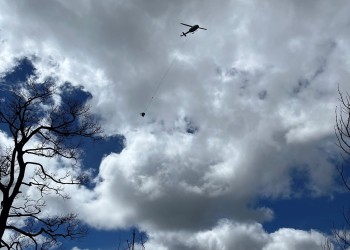Post-Fire Restoration on the Smokey Bear Ranger District
Smokey Bear Engine Bay at the time of the Southfork Fire in 2024.
(USDA Forest Service photo by Errick Kimbrell)In recent years, the Smokey Bear Ranger District and surrounding communities have endured a series of unprecedented wildfires and post-fire flooding. These events have left lasting impacts on our landscapes, wildlife, infrastructure, and the people who call this place home.
Our Disaster Recovery Team is here to share the journey of what happened, what’s underway, and what lies ahead. Recovery is more than rebuilding. It’s about restoring connections, protecting vital resources, and preparing our forest and communities for a stronger, more resilient future.
Recovering Post-Fire
The Lincoln National Forest, along with local communities and partner agencies, have faced several major wildfires in recent years including the McBride Fire (2022), Blue 2 Fire (2024), and the South Fork and Salt Fires (2024). Together, these events impacted more than 38,000 acres, with 17,208 acres located on Forest Service lands.
Smokey Bear Ranger District Disaster Recovery Areas Map showcasing Public Lands Affected by Fire.
(USDA Forest Service photo)While these Forest Service acres are a central focus of our long-term recovery efforts, we recognize that recovery must extend across the entire affected landscape.
Restoration work will prioritize forest health, infrastructure, and resource protection, both on Forest Service lands and in coordination with tribal, local, state, and federal partners managing adjacent areas. Together, we’re committed to a recovery that is inclusive, resilient, and landscape wide. Building not just back, but better.
To support this broader effort, the Forest Service, Southwestern Region awarded $13.5 million to the New Mexico Energy, Minerals, and Natural Resource Department (EMNRD) - Forestry Division through a domestic grant in June 2025. This funding came directly from the Forest Service's South Fork/Blue 2 Disaster Recovery funding we received under the American Relief Act in December 2024. These funds were given to EMNRD to support their South Fork Fire – Watershed Stabilization Program enabling critical restoration work on state and private lands.
We’ve also partnered closely with the Mescalero Apache Tribe since the initial post-fire response, collaborating on seeding, mulching, reforestation, and watershed initiatives. Ongoing coordination with local and state partners continues to drive landscape-scale restoration, addressing watershed health, access, and hazard mitigation across jurisdictional boundaries. This unified approach ensures recovery is comprehensive, connected, and built to last.
Lincoln National Forest Recovery Team with the National Forest Foundation during a field visit in 2025 to plan long term recovery projects within the burned area.
(USDA Forest Service photo by Tanner Nygren)Our Approach
Initial Post-Fire Efforts

Learn how the Lincoln National Forest launched immediate post-fire recovery efforts, from erosion control to infrastructure stabilization, by visiting our Initial Post-Fire Efforts page.
Disaster Recovery Efforts

See how recovery is unfolding across the South Fork and Salt Fire burn areas. Hazard tree removal, trail stabilization, and cultural site protection are already underway. Learn more about the progress and what's next for long-term resilience.
Looking Ahead: The Next 5 Years

Big changes are coming to the Lincoln National Forest. See how recovery is shifting from planning to action. From watershed assessments to federal clearances, crews are laying the groundwork for restoration that lasts. Click to explore the full timeline and what’s ahead through 2030.
Follow Our Recovery
Disaster recovery is a long-term commitment, and the Lincoln National Forest is in it for the long haul. As recovery continues, we’re dedicated to sharing the full scope of this effort, from on-the-groundwork to the partnerships and planning that make it possible. Transparency and collaboration are key, and we’re working closely with local communities, tribal partners, and stakeholders to keep everyone informed and engaged.
We’ll provide regular updates on progress, milestones, and lessons learned, along with details about upcoming community meetings and volunteer opportunities. To follow our journey and get involved, stay connected through our Lincoln National Forest Website and social media channel Lincoln National Forest Facebook. This recovery is about more than restoring landscapes, it’s about trust, relationships, and building a more resilient future for all.
Current progress table with main recovery initiatives and their timelines laid out over the next 5-years with a current green progress bar on 2025.
(USDA Forest Service photo)Over the next five years, the Lincoln National Forest will be moving through a structured recovery timeline began with assessments and clearances to meet federal compliance requirements, including cultural resources, protected species, and environmental impacts. Once these legal obligations are fulfilled, we will transition to implementation of key recovery projects. The final phase will be monitoring, which provides essential quality checks: evaluating project success, infrastructure durability, and identifying areas that may need revisiting. By the end of 2030, the Lincoln National Forest will have completed its Disaster Recovery Plan, restoring resilience across the landscape.












